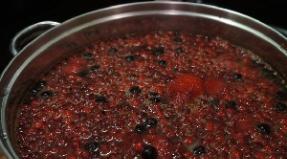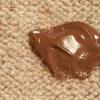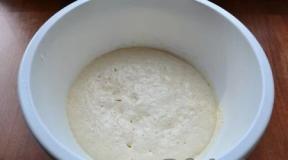Black Sea mussels: properties and recipes. How to cook mussels in shells
Mussels- This is one of the most common types of sea or river molluscs. Currently, there are a large number of special farms where mussels are grown for further sale.
The appearance of the mussels is distinguished by a dark oval shell (see photo). The color of the shell may vary depending on where it lives. Most often, the mussel shell is purple, brown or greenish.
Gourmets around the world love to eat mussels, which vaguely resemble oysters, but the taste of these two molluscs is significantly different. In addition, oysters have a muscle that holds the valves together, while mussels lack such muscles, which makes it much easier to open the shell. Therefore, the cost of mussels is much lower than the cost of oysters.
Types of mussels
At the moment, there are a large number of different types of mussels, some of which are very difficult to distinguish from each other without opening the shell. But in general, there are three main types of mussels:
- black sea,
- edible,
- mussel gray.
These types of mussels differ in their habitat, shape and color. So, the Black Sea mussel lives or is grown in the Black Sea. The edible mussel comes from the Atlantic Ocean, and the Gray mussel comes from Japan. These mussels live at a depth of five meters, the maximum depth is twenty meters.
 |
 |
 |
In order to properly and tasty cook mussels, first you need to choose the right one, so as not to buy spoiled goods. To do this, we decided to give you a list of recommendations, using which you can choose the right mussels, so that you can then prepare a tasty and healthy dish. 
- The first step is to pay attention to the integrity of the mussel shell. It must not be damaged, scratched or cracked. Also, the sink must be closed, since open mussels cannot be stored for a long time.
- If you don't hear a loud click when opening the shell, this means that the mussel is probably stale.
- If you want to buy frozen mussels, make sure they don't stick together in the bag or box.
- The color of the clam inside the shell should be white, cream, or pink. If you see mussel meat of any other color, it means that the product is stale.
- The mussels you buy should smell only of the sea or iodine, but not other extraneous odors.
- Be suspicious of mussels that are too heavy. It is possible that there may be sand inside the shell.
There are several varieties of mussels that can be seen on the market: frozen, canned, and fresh. Be very careful with the purchase so as not to spoil the impression of the dish.
How to cook and how to eat mussels?
There are several ways to prepare mussels. First of all, it is necessary to clarify that mussels should be cooked no later than 36 hours after purchase, otherwise they may deteriorate... Before cooking mussels, it is always necessary to open, remove the clam and rinse it thoroughly in water to remove any dirt and sand that may be in it.
Next, boil the mussels in a large saucepan. In order to diversify the taste of ready-made mussels, you can add herbs, spices and salt to boiling water. Add everything to your liking, but don't overdo it. Boil mussels for at least seven minutes if they are fresh, and at least ten minutes if they are frozen. 
You can also cook mussels in the sink, but for this you will need to rinse them thoroughly, then put them in boiling water and boil for about ten minutes. After that, you will need to drain the water, boil a new one, add spices, and put the mussels there again. They will be ready when their shells open on their own.
There are many recipes for mussel dishes. You can make paella, salad, soup, mashed potatoes, sauce with them, you can stew them, stir fry or marinate them. In any case, you need to eat mussels along with wine, which will perfectly complement their amazing taste. In our article you can see a photo of the finished dish to make sure that the mussels look very appetizing!
 Benefit and harm
Benefit and harm
The benefits of mussels are undeniable, since, thanks to their unique composition, it is possible to restore damaged sectors of the nervous system and provide the body with the necessary energy. Due to the high content of vitamins and trace elements in mussels, they have a beneficial effect on the human immune system, help in the treatment of colds or viral diseases, have a positive effect on blood vessels and the process of hematopoiesis in general.
Also mussels have long been are a powerful aphrodisiac... Regular consumption of mussels increases libido and also increases stress resistance. Also, mussels can act as a dietary product, since their calorie content is quite low. 
Mussels can only cause harm if this product is overused. Mussels are beneficial only if used wisely.
Mussel composition
The energetic composition of mussels explains their usefulness to us. These molluscs contain a large amount of vitamins such as A, E, C, D and the group of vitamins B. In addition to them, the mussels include various trace elements: zinc, iron, iodine, potassium and calcium, and many others. Due to such a rich composition, mussels can undoubtedly benefit the human body.
From time immemorial, the sea has helped people in difficult times. During wars and famine, in Anapa it was always possible to get food in the form of anchovy, gobies and other fish. Today, when there are no problems with food, we take its delicacies from the sea - oysters and mussels. The Black Sea mussel is becoming one of the favorite and healthy products of the local, and restaurants across the country want to see only fresh shells in their kitchens. Today's story will focus on the most valuable mollusk of the sea - mussels.
Appearance
The mussel is a bivalve mollusk, its home is two identical shell doors that develop and grow with its inhabitant. The shell of the mussel has an oblong shape, towards the end it turns into a kind of triangle. The outer surface of a young shell is smooth, but as it grows, growths appear on the valves. The interior is polished to a high shine and remains pure and mother-of-pearl throughout its life.
The color of the shell differs and depends on the external conditions and residence, but the main colors are brown, dark blue or purple. The mollusk itself is hidden inside the house; among its insides, muscle locks are clearly visible, which are responsible for the timely closing and opening of the shell doors. The usual size of the mussel valves, which are mined in Anapa, is 5-7 centimeters. Sometimes you come across houses up to 10 centimeters or more. Inside, the mollusk develops to a size of 2-3 centimeters. The life time of mussels is about eight years.
Habits
Mussels can move along the bottom, but prefer to exist in groups and peculiar colonies. For life, mussels find large protruding pitfalls, they can form a dwelling on piles, piers and other irregularities. Favorite depths for mussels are 5-40 meters. Seashells have a special gland that creates a thin but strong thread that connects the owner and the place of permanent residence with strong bonds.
Mussels are ready to start breeding in centimeter form, 1 or 2 years after birth. In shells, there is a clear division into males and females. It is very difficult to determine the sex of a mollusk by its appearance.
Spawning begins in the middle of summer. Fertilization of larvae takes place directly in the water column, where mussels sweep out reproductive products. Conceived mussels exist in the form of plankton, then sink to the bottom and mature.
Mussels are natural filters that pass hundreds of liters of water through them to obtain nutrients. The smallest plankton settles on the gills, and then enters the mollusk esophagus. Thanks to the muscular legs, the mollusk slightly opens the flaps for the flow of water and further processing and purification of the liquid.
Due to their filtration capacity, mussels are full-fledged lungs of the Black Sea. Each mollusk drives more than 70 liters of water per day, cleaning its bacteria and harmful organisms. It is noticed that in the accumulation of mussel colonies there is always clean and transparent water. Due to this feature, it is not recommended to consume the shell raw, especially if it is caught in polluted water. Despite this, gourmets from southern European countries believe that eating mussels raw is much healthier.
Thanks to a detailed study of the way of life of mussels, production for the growth of a valuable mollusk has been established in Anapa. It turned out that growing shells is more profitable than constantly harvesting. The most significant mussel farm is located in the Utrish region, where mussels breed on long collectors that extend into the water column. Due to the excellent food supply, mussels bear a large offspring. Fresh mussels are immediately sent to the shops and kitchens of Anapa restaurants. The main nutritional value of shellfish is protein. This valuable protein is better absorbed by the body than meat.
Outside of water, the mussel can remain alive for more than two days. The mussel got this ability due to the fact that inside the shell the mollusk retains nutrients and water necessary for life.
The main enemy of the beloved midi in Anapa is the predatory mollusk rapana, which has significantly reduced the number of bivalve shells in the last decade. Rapana boldly drills the flaps with its tongue and sucks the mussel through the formed passage.
Where to catch mussels in Anapa
It is impossible to return to the times when large mussels populated the piles of the Anapa pier on the central beach. Mussels could be caught on pebbles at a depth of three or four meters. Today, large colonies of mussels go deep into the sea, fearing their enemy Rapana. For self-extraction of mussels in Anapa, you need professional equipment for diving. A mollusk can be found at depths over 15 meters.
We advise you to go to the mussel farm in the village of Utrish, where you can buy your favorite shellfish for lunch. There is also a choice of fresh mussels. Let us remind you that there are several fish restaurants in the resort.
The edible parts of the mussels are the muscles with the mantle and entrails. They are packed with protein, fat and carbohydrates, which is why mussel dishes are very nutritious. If you bought the meat of peeled mussels, then you need to rinse it from the sand, and then you can boil or fry. The main thing is not to add too many spices and sauces, so as not to "hamper" the unique taste of the mussels.
Mussels in shells are boiled in water, wine, or broth for a few minutes. After a few minutes of boiling, the shells open and you can extract tender tasty meat from them!
Mussels, they are also mytilids, are a family of marine bivalve molluscs. Mussels are found in all seas and oceans of our planet. Many species of these molluscs are the most important fish species, along with oysters.
Mussels were eaten 70,000 years ago! Numerous archaeological finds prove this fact. Mussels were cooked in ancient Rome, and they have always been considered tasty, healthy and cheap seafood.
Today mussels are a delicacy, and the annual world turnover of this seafood exceeds 1.5 million tons!
Mussels that have reached one and a half years of age and are 8 cm in size are used for food.
Already in the 18th century, mussels were learned to grow artificially, making this product even more affordable.
Mussels are not only distinguished by the most delicate taste, but are also rich in useful substances. For example, protein, which is more in mussels than in beef and any fish. At the same time, mussels are a low-calorie product. The presence of mineral salts, iron, phosphorus and vitamins in the product makes it even more useful. Mussels are a natural source of antioxidants, they are high in vitamins B, D and E.
On a note: 100 grams of mussels contain 25% of the daily value of vitamin E.
In the meat of mussels, there are relatively many polyunsaturated fatty acids necessary for the body for brain activity and vision.
Mussels improve metabolism, stimulate blood circulation and strengthen the immune system.
Mussel meat is useful for blood diseases and even with an increased level of radiation.
Note: Mussels have been clinically proven to reduce the risk of cancer! And a large amount of protein has a good effect on liver function.
A large number of mussels can lead to allergies, including cross, that is, due to the similarity of allergenic structures.
Mussels are contraindicated for people suffering from bleeding disorders.
You can not eat mussels with gout, because their meat is saturated with protein compounds that are converted into uric acid, which forms crystals deposited in the joints, which increases pain.
Mussel composition
in 100 grams of product
| The nutritional value | Vitamins | Macronutrients | Trace elements |
|
Caloric content 77 kcal |
Vitamin PP 1.6 mg Vitamin A 0.06 mg Vitamin A (RE) 60 μg Vitamin B1 (thiamine) 0.1 mg Vitamin B2 (riboflavin) 0.14 mg Vitamin C 1 mg Vitamin E (TE) 0.9 mg Vitamin PP (Niacin Equivalent) 3.7 mg |
Calcium 50 mg |
Iron 3.2 mg |
| How to choose mussels |
- Choose mussels with tightly closed valves and no damage.
- All shells and cracks and cracks are unusable.
- There should be nothing dangling inside the sink.
- The weight of the mussel must be appropriate for its size, and shells of the same size must have the same weight.
- There should be no extraneous odors, especially unpleasant ones.
- Resistance should be felt when trying to open the sink.
- Sinks should not be too dirty with sand and silt.
- Sinks that open themselves during washing and cleaning are not edible.
- Don't go for shallow shells as they are low on meat.
| How to store mussels |
If you bought vacuum-sealed mussels, you can store them in the refrigerator for the specified storage date.
Loose mussels must be put in cold water and pressed down with a small weight on each shell so that they do not open. The main thing is not to crush them and use them as quickly as possible. In this form, mussels are practically not stored.
Mussels can also be stored on ice by placing them on a wire rack to drain the thawed water, but only for a few days.
Mussels are eaten boiled, baked, fried, as well as dried, pickled, smoked, salted, and even raw.
Boiled mussels have a pleasant sweet taste.
You can serve cooked mussel meat on skewers, which will greatly facilitate the process of eating them. Mussels cooked in shells are served with special cutlery - a special fork and tongs - with which you can open the mussel and take out the meat.
Mussels go well with many foods and drinks, just like other seafood. This dish is served with dry white wine or light beer. Mussels with lemon are good. When preparing mussel soup, classic onions, garlic and parsley are usually added there.

| Types of edible mussels |
Korean mussels - are mined in Russia, on the coast of the Sea of Japan. They reach 14 cm, but in the store their size is usually about 60 mm.
Edible mussels - are mined in the Okhotsk, Bering, Barents, Baltic seas, as well as in Greenland and Iceland. They reach 10 cm, in stores their size is up to 80 mm. This is the most common type of mussel.
Mediterranean mussels - are mined in the Mediterranean, Black, Azov, Japanese and other seas. Reach 14 cm, marketable size - from 50 mm. One of the most common types of edible mussels.
Pacific mussels - are mined on the coasts of the Pacific Ocean. Reach 9 cm, marketable size - 50 mm.
Mussels Gray- are mined in the Sea of Japan and Okhotsk, on the Kuril Islands. Reach 170 mm, marketable size - 50 mm.
| How to peel and boil mussels |
If you bought frozen mussels, then you need to defrost them in cold water, covering them with a load that prevents the shells from opening.
After that, the shells must be removed from the antennae and cleaned of silt and sand. But first, it is necessary to discard all shells that have opened or have any damage.
On a note: A good way to remove the sand from the inside of mussels is cornmeal, which must be dissolved in cold water and placed in the shells for about an hour.
To rid the mussels of the antennae, you need to pull them towards the base of the shell.
Outside, the sinks are cleaned under running water with a stiff brush.
Cooking mussels is best done immediately after cleaning.
On a note: If the mussel did not open during the cooking process, it is spoiled and will have to be thrown away!
Boil mussels for no more than 5 minutes otherwise the meat may become tough. You can cook the mussels in a skillet under the lid, pouring plenty of water or white wine. In this case, the water must completely cover the sinks. This will steam the mussels. Cooking mussels should be over medium heat, shaking occasionally. After five minutes, you can remove the mussels from the heat and discard any shells with closed flaps.
| Interesting facts about mussels |
- The main competitors for human consumption of mussels for food are starfish, which in some areas put these mollusks under threat of extinction.
- The largest number of mussel farms are concentrated in Galicia (Ukraine and Poland).
- The largest mussel found was 60 centimeters.
- There are freshwater Zebra mussels that are inedible.
| World market of mussels |
The main suppliers of mussels to the world market are Spain, Chile, Scotland and Australia. At the same time, Chile is most actively increasing the volume of supplies. Thus, the production of mussels in Chile in 2010 amounted to about 192,000 tons, which is 33% more than in 2009. This growth allowed to increase exports by 30.6%. And the price increased by 18%.
Chilean mussel grower Empresa Pesquera Apiao S. A. is Friend of the Sea certified to ensure that the mussels it supplies are produced in a sustainable and environmentally friendly manner. The Scottish Shellfish Marketing Group (SSMG), the Tasmanian Spring Bay Mussels and others have also been awarded the Friend of the Sea certificate.
| Main sellers of mussels in Russia |
Korsakov cannery (Sakhalin Region). Products: mussels, fish, shrimps, squid, scallops, caviar.
Company "Sea freshness" (Moscow). Products: mussels, fish dumplings, frog legs, snails, scallops, cuttlefish, octopus, lobsters, lobsters, lobsters, shrimps, trout, crabs, squid, caviar.
Ochakovskiy mussel and oyster fish canning plant (Ukraine). Products: mussels and oysters, seafood preserves, canned fish.
Fishing collective farm "Rodina" (Yuzhno-Kurilsk, Sakhalin Region). Products: mussels, fish, octopus, seafood, shellfish, seaweed, shrimp, caviar, scallop.
Fishing collective farm them. Kirov (Sakhalin Region). Products: mussels, fish, preserves, canned food, caviar.
Company "Sant" , TPK (Ufa). Products: mussels, seafood cocktail, gourmet fish, trout, beluga, salmon.
Sakhalin Union of Fishing Collective Farms
(Yuzhno-Sakhalinsk). Products: mussels, fish balyk, seaweed, shrimp, scallops, fish oil, caviar.
Kholmsk fishing collective farm (Sakhalin Region). Products: mussels, herring, octopus, fishmeal, seaweed, shrimp, fish oil, caviar.
Mussels (and also mytilids) - this is the name of the marine bivalve molluscs that live throughout the world's oceans and have been eaten by humans since time immemorial.
The most popular for cooking from edible mussels are the Black Sea mussels and, caught in the cold seas of Japan and the Sea of Okhotsk, as well as in the northwestern Pacific Ocean, Gray mussels (or giant mussels).
 Every year, during the season of active fishing / harvesting of these delicious mollusks (at the very end of August) in the small Belgian village of Erseke, Mosseldag (Mussel Day) is held - a holiday during which in local restaurants and cafes people eat a huge amount of shellfish. By the way, the only one in the world "Mussel Exchange" is located here, so there is no end to buyers (retail and wholesale), as well as from tourists, as they say.
Every year, during the season of active fishing / harvesting of these delicious mollusks (at the very end of August) in the small Belgian village of Erseke, Mosseldag (Mussel Day) is held - a holiday during which in local restaurants and cafes people eat a huge amount of shellfish. By the way, the only one in the world "Mussel Exchange" is located here, so there is no end to buyers (retail and wholesale), as well as from tourists, as they say.
Now mussels are not only caught in their natural habitat, but also artificially grown on special platform farms. And the cost of the meat of such mussels in refrigerated display cases in supermarkets is somewhat cheaper than the meat of their "wild" counterparts.
Nutritional value and chemical composition of mussels
The nutritional value:
- Caloric value: 77 kcal
- Protein: 11.5 g
- Fat: 2 gr
- Carbohydrates: 3.3 g
- Water: 82 gr
- Saturated Fatty Acids: 0.4 g
- Cholesterol: 40 mg
- Ash: 1.6 g
Macronutrients:
- Calcium: 50 mg
- Magnesium: 30 mg
- Sodium: 290 mg
- Potassium: 310 mg
- Phosphorus: 210 mg
- Sulfur: 115 mg
Vitamins:
- Vitamin PP: 1.6 mg
- Vitamin A: 0.06 mg
- Vitamin A (RE): 60 mcg
- Vitamin B1 (thiamin): 0.1 mg
- Vitamin B2 (riboflavin): 0.14 mg
- Vitamin C: 1 mg
- Vitamin E (TE): 0.9 mg
- Vitamin PP (Niacin Equivalent): 3.7 mg
Trace elements:
- Iron: 3.2 mg
Mussels are one of the lowest calorie foods that modern humans eat. They are rich in healthy proteins (by the way, there are much more proteins in mussels than in any fish or even meat) and contain almost no carbohydrates.
Why are mussels useful?
The benefits of mussels are determined by the composition of their meat (muscle), as well as the mantle and shell fluid, which are also used to prepare delicious dishes.
The inclusion of mussels in the diet of a modern person (with regular use) provides:
- improving metabolism;
- increased immune status.
Mussel meat is the product that can provide a fairly reliable prevention of arthritis. And besides, such meat stimulates:
- circulation;
- elimination of toxins and toxins from the body.
Mussel meat is literally saturated with mineral salts, vitamins (here almost the entire group B, as well as vitamins PP, E and D), microelements. Mussels are rich in phosphorus, iron, manganese, zinc and cobalt. High in iodine, as well as useful polyunsaturated fatty acids.
 Like any seafood, mussels are beneficial for activities. .
They also improve mood and prevent numerous nervous disorders. Regular consumption of mussels in food is a guarantee of bone strength, prolongation of external youth, maintenance of the natural beauty of skin and hair.
Like any seafood, mussels are beneficial for activities. .
They also improve mood and prevent numerous nervous disorders. Regular consumption of mussels in food is a guarantee of bone strength, prolongation of external youth, maintenance of the natural beauty of skin and hair.
The positive effect of meat, mantle and mussel shell fluid on male potency has been proven. Some doctors even call this product "natural Viagra".
But for children, pregnant and lactating women, mussels are little recommended because of some features of their existence that can affect the quality of nutrition of these population groups. So, not everyone can appreciate the beneficial properties of mussels.
Why are mussels harmful?
Mussels can be harmful to human health. Especially if they do not pass the obligatory pre-sale preparation (we are talking about mollusks living in their natural habitat). They can disrupt blood clotting and can cause serious allergic reactions.
In addition, the harm of mussels has been proven for patients suffering from gout, since in the human body protein compounds are converted into uric acid, and it can be painfully deposited in the joints.
But in general, mussels have few contraindications. In fact, anyone can eat these shellfish in reasonable quantities. Unless, of course, there is an individual intolerance to seafood.
Features of the preparation and use of mussels
 Freshly caught mussels, unless they have been grown artificially on special plantation farms, cannot be eaten. They must be kept (and not less than a month) in fresh sedimentation reservoirs.
Freshly caught mussels, unless they have been grown artificially on special plantation farms, cannot be eaten. They must be kept (and not less than a month) in fresh sedimentation reservoirs.
The fact is that these valve molluscs are living natural filters, the mission of which is to cleanse the natural environment of their own habitat. They are capable of accumulating toxins and microorganisms harmful to human health. And they just need a fairly long quarantine to get rid of the sometimes openly dangerous "baggage".
 When buying mussels at the supermarket, it is best to choose frozen packages. Unless you live next to the above described shellfish farm. And it is worth paying attention to the appearance of the purchase - if the mussels have stuck together into an ice lump, there is a great danger that they have already been thawed once. And maybe even deteriorated.
When buying mussels at the supermarket, it is best to choose frozen packages. Unless you live next to the above described shellfish farm. And it is worth paying attention to the appearance of the purchase - if the mussels have stuck together into an ice lump, there is a great danger that they have already been thawed once. And maybe even deteriorated.
Mussels are probably known to every person, as they are found in freshwater bodies of water and seas everywhere. The Black Sea species (Mytilus galloprovincialis) can be found in the Atlantic, Indian and Pacific Oceans. The meat of the bivalve mollusk tastes good, is rich in vitamins and microelements. It is widely used in cooking and is considered a delicacy, especially in the cuisine of coastal peoples. But mussels are also an important part of aquatic ecosystems, including the Black Sea, passing through themselves, filtering and purifying tons of water.
General characteristics of mussels
Mussels belong to bivalve molluscs and are named because of the structure of the shell, which has two identical and symmetrical valves, which are closed with a protein ligament and "teeth-lock". The external skeleton not only protects the delicate body and internal organs of the mollusk from external danger and predators, but also participates in the process of feeding and movement. The shell is composed of calcium minerals, increasing in size every year. The total number of years can be counted by the rings on the surface or the layers on its cut. Usually, bivalves live from 2 to 5 years, reaching an average of 10-15 centimeters in size.
The shell is very important for mussels and is the only protective agent, since they are representatives of a sedentary and immobile lifestyle. Mussels live on a muddy bottom or hard surfaces, attaching to them with the help of a special protein enzyme byssus. Often, mollusks gather in huge colonies (druses), clinging to each other. Bivalves are very prolific and numerous, therefore such "communities" can number hundreds and thousands of individuals.
Colony of mussels on a rusty pile
Mussels feed on organic substances in the water, "sucking" it into the shell with the help of siphons, filtering and returning the "clean" one back. This feeding feature makes bivalves an important element of ecosystems, and turns their numbers into real filtering and treatment "stations". She also repels some people from eating mussels - the shellfish accumulates what was in the water, so they consider its meat "contaminated".
One of the most widespread and numerous species of mussels is the Black Sea mussel, described in 1819 by the French biologist Jean Baptiste Lamarck. This bivalve mollusk does not live only in the Arctic Ocean, and its meat was even included in the diet of the North American Indians.
Adult specimens of the Black Sea mussel have an oblong shape of 10-12 centimeters in length, with a dark shell, and are not long-livers. Mollusks prefer to choose their habitats in muddy areas of the seabed or on the hard surfaces of reefs, stones and breakwaters, on which colonies of many thousands are found. They can be found in coastal waters around the coast. Black Sea, but some representatives have been seen at depths of 20-30 meters.
 Platter with mussels
Platter with mussels
The Black Sea mussel is an edible species and is an object of commercial fishing. Shellfish meat is considered dietary, rich in protein and amino acids, vitamins A, B and D. Nutritionists recommend eating it to strengthen the immune system, normalize metabolism and "purify" the blood. Mussels are not only harvested in their natural environment, but also grown on special farms, from where the meat goes to shops and restaurants, while only the shell, byssus and the protein bundle that closes the shell valves are not eaten.
Features of the Black Sea mussels
A feature of the Black Sea mussel can be considered its ability to form pearls that have no gem value, but can still look quite attractive. In their bulk, these are formations of a "muddy" color and irregular shape, and there may be several of them inside one shell.
 Mussels
Mussels The inability of the Black Sea mussels to defend themselves against their most dangerous enemy -



















